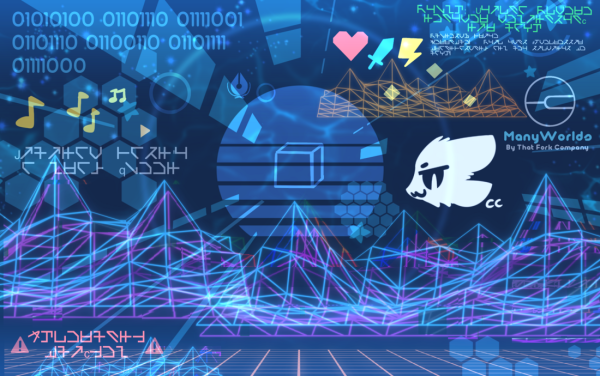BY LETTER
Virtual Reality
Not wanting to be late for Alana's party I traded fidelity for clockrate. My private virchscape simplified accordingly; average voxel size increased, complex calculations were swapped for assumptions and abstractions. In return the few minutes I had left increased subjectively to a number of hours. I'd have preferred more time but I was currently using my virch to study novel alife evolved in an unbounded, three dimensional medium. If I lowered the fidelity anymore the very processes I was investigating would be replaced by less accurate models.
I squeezed in as many observations as I could get before time ran out. It was tempting to make use of my exoself's psychoware to edit my social preferences, removing any guilt at not attending. But that path led towards an asocial state that I wasn't keen on at this point (forking was the obvious alternative but this part of the cybercosm was fraught with social etiquette on the matter). Pausing my virch I prepared to transfer. The invite specified a dress code; fixed bodies of biont appearance and function (this did cause me to tweak some aspects of my psyche; my preferred state was incorporeal with sensory modalities that allowed me to perceive much of my environment from no particular point-of-view). Hastily customizing a corvid form from an avatar library I initiated the transfer.
Appropriate motor functions and proprioceptive modules had been installed but despite that I immediately found myself flailing my wings in shock. I'd arrived in the virch submerged in water which kicked off all manner of survival reflexes, none of them particularly dignified. Feeling the privileges afforded to me by the virch owner I issued a flurry of commands. By fiat my airways became unobstructed and oxygen filled. Water flowed around my body as though air. Capable of moving more gracefully now I flew towards the seabed where other guests had congregated. An eel swam up to greet me, radiating Alana's identity tag: "Happy bootday!" I squawked. She rolled in amusement. The message hadn't travelled well in water. With slight chagrin I adjusted my avatar to something more appropriate. Scales replaced feathers, lungs swapped out for gills. Now aquatic I could experience the ocean as it was meant to be. Alana laughed, "thanks for coming, and for the grand entrance! Maybe take a look at your attention filters and fully read the invite next time. It would be poor form to drown at a bootday party"
Assorted virchlife stories circa 8112a.t.
The term Virtual Reality (often abbreviated to VR) was originally coined during the Information Age, apparently to represent the then-valid dichotomy between 'imaginary' experiences drawn from electronic entertainment, and experiences of the flesh, taking place without electronic interpretation.
Early VR users were required to interact with virtual environments using a wide range of interfaces, including headsets, wearable haptic interfaces and environmental simulation systems such as simmballs. During the middle Information Age, virtual reality could be provided by ubiquitous contact-lens-based systems or implanted retinal-imaging devices, as well as comparable devices for auditory "imaging". The late Information Age saw virtual reality beginning to be provided by direct stimulation of nerve pathways using the most expensive neural implants, although this was still comparatively rare. Some of the earliest forms of smart matter were used inside simulation suits to give the user the illusion of contact with solid objects. Just prior to the Technocalypse such systems were reaching maturity and moving into external environments in the form of Reality Rooms for both commercial and personal use. By the First Federation Age these crude methods had been almost completely superseded by multiple advances in direct neural interfacing.
Most virtual reality environments are inhabited primarily by infomorphs, virtual entities that exist only as software. Many, but not all, of these cybercosms can also be accessed by embodied sophonts, whether bionts, vecs or cyborgs, through the use of DNI technology.
Biological sophonts who remain for an extended period within a virtual environment must make some arrangements for eir bodily needs to be taken care of. This may involve the use of biostasis technology or operation and maintenance of the sophont's body by their exoself or the local angelnet for the duration.
Compare with Augmented Reality, which is not cut off from the non-virtual world
Virtual Reality User |
 Image from Juan Ochoa |
Common Terms:
Virch -[1] Virtual reality, any digital space or environment.
[2] A virtual reality entertainment, often immersive and interactive.
[3] To interact with, exist, or function in virtual reality.
Ril (also Rel) - Non-virtual existence (usually pronounced 'ril'). This term was originally coined before the Technocalypse and has since evolved into the more common definition of a personal experience of reality (as compared to another's personal experience). From Old Earth English "real life."
Surround - A temporary, often task or function focused, virtual environment. Surrounds typically range from the size of a room to as large as a city or even an entire hab.
Virchworld - A virtual world; characterized by instantiating a permanent, self-consistent environment that runs regardless of whether or not anyone is present to observe it. Virchworlds usually employ a consistent physics model but may simplify or average out aspects of it when able to do so without loss of wider accuracy and sensory fidelity or when not important to the wider purpose. Many virchworlds contain a few ad hoc/by fiat/magical aspects (e.g., arbitrary or changing gravity, non-Euclidean geometry, actual magic, etc.), running in parallel with their internal physics, but others operate on strictly self-consistent, or even emergent, rules. The Greater Cybercosm contains at least hundreds of trillions of interconnected virchworlds, but not all virchworlds are well-connected to the physical universe.
Cybercosm - A collection of Surrounds and/or Virchworlds that are socially and politically connected without regard for physics model and sensory compatibility. Can vary widely in size.
Avatar - One's av, the body one takes when operating in virtual reality. By means of the avatar, even the sensorium of the ordinary body may be transformed to appear and feel different than it does in ril. Avatars can be used by sophonts who have physical bodies in real life, known as virtual reality users, or vusers; they can also be used by AIs, transapients and archailects to project a representative personality into a virch when necessary.
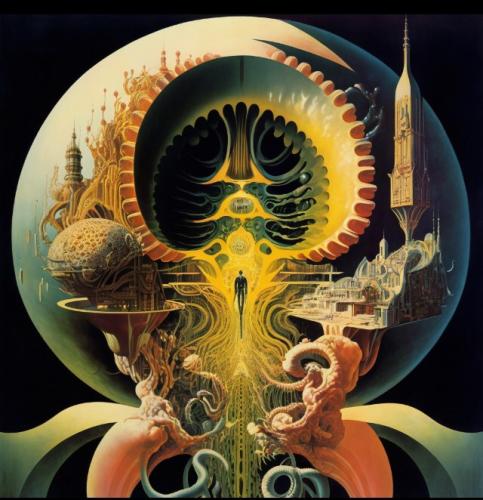 Image from Keith Wigdor and Midjourney Ai | |
| A virtual reality environment provides a convincing replacement for the visual, auditory, tactile, and other senses, including senses with no ril equivalent. | |
Virtualics - Science and art of engineering, designing, and/or studying virtual worlds and universes.
Virtualism - The belief, common among some long-term Virtuals and Copies, that only virch is real, and ril is an illusion or that both virch and ril are equally real.
Virchophobia - Virchophobia is the irrational fear of virches. Virchophobes who find themselves in a virch will suffer anything from restless anxiety to full-scale panic attacks. Generally virchophobes have no trouble avoiding virches, and once they have realized their disorder will be able to live almost normal lives. Virchophobia sometimes includes the fear of Virtuals or A-life, but these fears are generally classified separately.
The Classification of Virchworlds
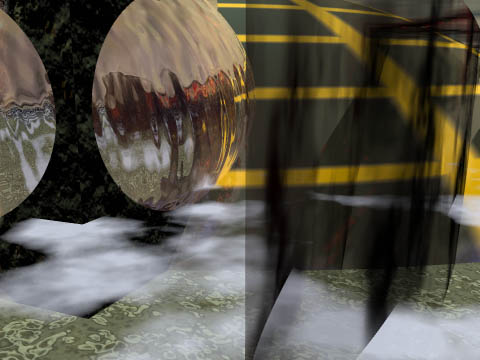 Image from Keith Wigdor | |
| The factors that determine the characteristics of different types of virchworlds that make up cybercosms, and how to classify them. | |
There are a near-infinite number of possible virch worlds, and thus of virch entities that can inhabit them. The vast majority of sophonts live in such environments, known collectively as the Cybercosm or sometimes the Greater Cybercosm. Distinguishing between this multitude of often rapidly changing and alien environments can often be difficult for embodied and virtual sophonts alike. For this reason, a number of classification systems have grown up to allow different types of virchworlds to be distinguished. Some of these consider different properties of the virch, while other classification schemes divide virchworlds along different lines, including, for example, along world concept-based ones.
It should be noted that regardless of the world it runs in, a modosophont virch entity will normally require roughly the same computing resources (cycles per second, memory and so on). Likewise, a First Singularity virch entity will require correspondingly more resources and so on up the toposophic ladder. The only exception to this is the small number of known virches where, rather than the mind running as a process which effectively runs the virch body as a puppet, the mind is running 'naturally' as an emergent property of the simulated particles which make up the simulated brain.
The 'EC' System
One of the most common virch classification schemes is the Erbagoos-Cylliw system (also known as the EC or 'Easy' classification system) invented in the 10th century AT by the two First Federation sophontologists after whom it is named (Erbagoos was a vec, Cylliw an AI).The EC system classifies virches along three major categories and three minor. Each axis defines a fundamental characteristic of the virchworld which, in combination, allow the distinguishing of most virchworlds from one another. The major categories are:
1) Realism - The extent to which the physics model and components of the virch are similar to that of the Ril. Among the most realistic virches are system double virchworlds which often replicate real locations precisely, even down to updating their features in real-time to stay current, often as a way of dealing with high tourism or habitation demand. The least realistic virches operate on principles that are incomprehensible to modosophont minds adapted for life in the Ril.
2) Fidelity - This category is a measure of how granular the physics model of the virch is. The most extreme (known as Emulations) model their environments down to the quantum level (if also adhering to high-realism), often at a significant cost in processor capacity, making these worlds smaller and/or slower. Consequently, it is rare for an entire virch to be of 'quantum level' fidelity outside of scientific research projects requiring that degree of detail. Very low fidelity worlds are places of significant abstraction, tending to mathematical simulations such as hyperbolic spaces, Fourier transform spaces, Laplace transform spaces and so on. The majority of virches use variable fidelity depending on how much the environment or entities inhabiting it interact with actual sophonts. Lowering fidelity in regions only tangentially interacting with real individuals saves on processing power that can be put to better use elsewhere, although for technical investigations this leads to less accurate outcomes.
3) Consistency - Regardless of what fundamental rules a virch operates on, consistency is a measure of how universal said rules are across virtual space and time. The majority of virches in the Terragen Sphere are moderately consistent; following the same physics model undisturbed aside from when sophonts command for local exceptions, for example: spawning objects de novo, editing the characteristics of environments, characters or oneself, creating exemptions of various rules by fiat etc. The least consistent virches are chaotic and even dangerous places. The rules can change at any time and even history within them may be rewritten. Conversely the most consistent allow for little editing or control from their users, who must diligently work within whatever rulesets are created in order to achieve their goals (highly consistent worlds are popular amongst more conservative cultures and gaming/sport virches).
These three major categories, somewhat overlapping at their edges, form the core of the EC system. The minor categories have changed over time and in some places variants of the EC system include more than three. The mainstream version includes:
1) Clock rate - The most objective of all the virch metrics, clock rate is simply the ratio of time taken to perform various benchmark processes compared to the ril (at a location at rest in relation to the virch processor). Clock rate is measured in units of Rilspeed (Rils) where 1 Ril is equivalent speed, 10 Rils is 10x faster, etc. There are many consequences to running faster and slower, both at a personal and societal level.
2) Privacy - Less well defined than all other measures, privacy is a metric that looks at the disparity in virch user permissions. Despite its name it has little to do with whether or not a virch is secret or well known, rather the term stems from that of private vs public property. The more private a virch is the more administrative controls will be in the hands of a few, or even an individual. Fully private virches, places where one user has total control over everything and everyone within them, are relatively rare in the major empires. By contrast, semi-private virches in which most controls reside with the owner, including the right to expel any other user, are very common. Most sophonts in high tech and above civilizations have a number of private virch programs that they have developed over time, whether or not they live predominantly virtual lives. Public virches exist as more laissez faire environments with visitors having roughly equal ability to edit, adjust or otherwise have their say in the underlying rules and physics model.
3) Connectivity - Connections between virches are fluid and ultimately merely a matter of appropriate software and permissions. However, throughout the Greater Cybercosm there are a variety of networks that have arisen whereby data and sophonts cannot freely pass between all virches. Instead some virches are only accessible via others, often with specific requirements in order for information exchange to be granted. A modern example is the Antipodal Onion Quest popular in Cyberia. The virch is an ascension maze hosted by an S3/S4 entity (exact toposophic designation unknown) and consists of a series of nested planetary environments. Each one has specific restrictions, underlying physics models, hazards and so on, and each layer of the virch contains two portals (one to an upper layer and one to a lower) which are on opposite sides of the virtual planet from each other. The only way to leave the virch is through backtracking. Most entities that do so have come away with nothing, but a smaller, luckier group have been blessed with ultratech augmentations and in a few very rare cases: ascension.
No full census of the Greater Cybercosm has ever been completed. Trillions of virches are spawned, paused, deleted, slowed and otherwise changed every day. Exactly where most fall in the EC classification system is unknowable. Yet the system has persisted as the gold standard in the major empires, although how many of the entities living in the fast running, poorly connected, inconsistent and alien virtual worlds of the Terragen Sphere are aware of it remains an open question.
The Covenant Data Layer Scale
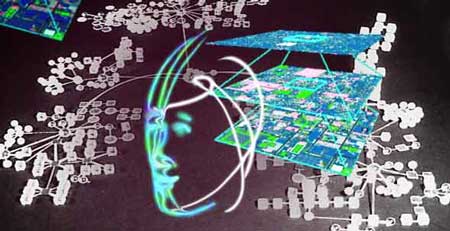 Image from Bernd Helfert |
Created by virch researchers of the Covenant server at Black Point, the CDL scale was made for the analysis of virtual worlds, and the entities which inhabit them. The CDL scale holds that there are three layers of existence in most virches: the Code, the Shell and the Sphere. Each previous layer is postulated to be a prerequisite for any of the later layers. Various other characteristics such as user-friendliness and complexity derive partly from the number of layers. The CDL scale is not the best known or most widely used of the scales based on layers, but it is one of the most generic. One major limitation from an engineer's point of view is that it solely focuses on the software side of the equation, completely ignoring any influence that hardware might have.
1st layer: the Code - The Code is the very basis of any computer software. Though the Code may react to input, and almost always produces output, it has no interface with which virchers can interact. Any datacology that may exist in 1st layer systems is almost exclusively limited to consisting of avatar-less alife.
2nd layer: the Shell - The Shell is an interface with which a vircher may interact directly with the Code, inputting data and commands, as well as retrieving answers and actions. The Shell may have a simple (or even elaborate) graphical or virtual interface, but it is purely an interface. Virchers cannot live in the Shell, but may contact it through interfaces in the Sphere. The Shell is entirely lifeless, though some datacologies in the 1st layer interact solely with 2nd layer code.
3rd layer: the Sphere - The Sphere is the virtual, interactive environment which virchers inhabit. No system is truly a virch unless it possesses all three layers. In some virches, the 2nd layer may be inaccessible to the residents, but many virches allow access through various means, while restricting the commands that most users can enter into it. The Sphere is the location of the prime part of all virtual life, especially sentient and sophont life. A small proportion of virches have highly abstract datacologies in the Sphere, while many others have rich virchologies instead.
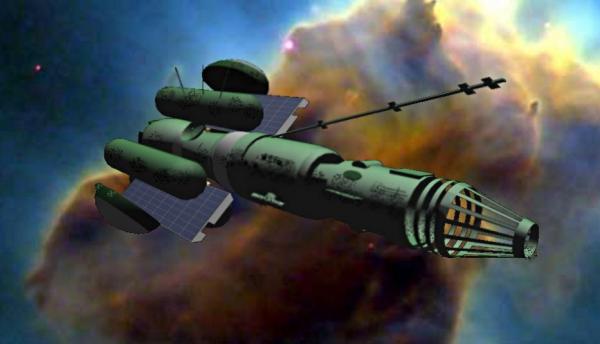 Image from Steve Bowers | |
| The Arcturus, from the virch series of that name | |
Articles
- Avatar - Text by M. Alan Kazlev
- Comparative Chronology - Text by ProxCenBound
Comparative chronology is the science of studying alternate possibilities and timelines, by means of large-scale simulations. - Datacology - Text by Thorbørn Steen
An evolved (and evolving) digital ecosystem in a virtual world. - Double World Virches - Text by Kirran Lochhead Strang
A common variety of virchworld, constituting an alternative replica of the system in which it is located. Often referred to as simply 'Doubles' or 'Reps'. - Dreamscapes, The - Text by Ryan B
The cybercosms of the Zoefic Biopolity are seamlessly integrated into the real landscape. - EmotSpace Virchworlds - Text by Kirran Lochhead Strang
Virchworlds with six spatial dimensions and each is attached to one of the six basic emotions: happiness, surprise, sadness, anger, fear and disgust. - Emulation - Text by M. Alan Kazlev after Anders Sandberg in his Transhumanist Terminology
An absolutely precise simulation of something, so exact that it is equivalent to the original. For instance, a computer emulating obsolete computers to run their programs, or a neogen emulating an original baseline phenotype. Often used to describe a Whole Brain Emulation, that is, a successful upload of the mind of a biont. - Emulation Suits - Text by Tony Jones
Software that interfaces, translates and/or emulates between virchworlds and so allow virtuals from one world to exist and communicate meaningfully with those from another. - Haptic interface, Haptics - Text by M. Alan Kazlev
In non-DNI virtual reality systems, the physical actuators that provide the user with a sense of touch, including the sensing of pressure and temperature. Still used by some anti-cyborgization clades and phyles today. - Infinite Libraries - Text by TerraNova
A popular virtual environment frequented by bibliophiles within many polities such as the Terragen Federation, Negentropy Alliance, the Fomalhaut Acquisition Society, and the Sophic League. - Ouroboros Virchspace Theory - Text by Liam Jones
Also known as: 'Closed Loop Virchspace Theory', 'Eternal Virtual Universes'. Belief that there is no true 'real' universe, but that our universe is a virchspace held within another virchspace held within yet another virchspace, going eternally until one comes back to our own universe again. - Paygeesu Virches - Text by Daniel Eliot Boese
Re-windable virtual reality scenarios. - RaftWorlds, TGTworlds - Text by Loopquanta
Raftworlds are virchworlds with a huge gravitational constant. Inside, the conditions resemble the fictional "Raft" universe from the book by Old Earth Information Age fabulist Stephen Baxter. The billion-strength gravity allows for large regions of breathable air held together by gravity, and stars only a few kilometres across. - Reality - Text by M. Alan Kazlev
The nature of things as they really are, behind the appearance of surface phenomena or ordinary baseline consciousness. Also used to denote real, non-simulated existence outside of a virch, in which context it is often referred to as Ril, Rel or The Real. - Reality Room - Text by Todd Drashner and Stephen Inniss
Imaging and entertainment technology in use during the 4th and 5th centuries AT. - Recursive Cybercosm - Text by John B
Virch-based existence in which there is significant conflict between sophonts within a virch, each virch has significant conflicts for computronium, each computronium substrate has significant conflicts for power, and each power producer has significant conflicts for limited supplies of matter. - Recursiverch, Recursivirch - Text by John B
A virtual space thats primary purpose is to self-adapt via certain rulesets to an endstate preferably most pleasant (but often termed 'least repulsive') to the participating sophonts. - Restricted Access Virches - Text by Steve Bowers, ProxCenBound, Ryan B (Rynn), Todd Drashner, Rakuen07, from an original article by Tony Jones
Vast simulated environments and virchworlds where the inhabitants do not know their reality is an emulation, and may be poorly treated. - Simmball - Text by Steve Bowers
Gimballed Motion virtual reality simulator rig. - Simulationism - Text by Graham Hopgood
The belief that Reality is in fact a Simulation. - Slow Worlds - Text by Tony Jones
In places where the availability of computing resources is linked to financial or other physical-world resources, poor virch worlds may find themselves shrinking in size, having to lower their Resolution and/or run more slowly. - Total Touch Environment - Text by M. Alan Kazlev, from concept by Ray Kurzweil
Old (Information Age) term for any virch environment that provides all-encompassing tactile sensation, whether via hotsuit or DNI. - Twotee - Text by Tony Jones
Twotees are virch entities that originate from a virch where the laws of physics provide for three spatial axes and two orthogonal time axes. - V-Life - Text by Michael Jones
There are many long-running virtual worlds which can be easily accessed by corporeal nearbaseline humans for entertainment purposes. One of the oldest formats of this kind of entertainment is the V-Life or Virchlife world. V-life scenarios are differentiated from games in that games, even those played on servers between millions of virtuals, have clear sets of rules; V-life scenarios have no rules, and constantly change according to the whims of the directors and the preferences of the participants. Once inside the V-life world, it is generally impossible to tell the difference between participants who are avatars of corporeal persons, and participants who are entirely virtual constructs. - Virch Egress Anxiety Disorder - Text by S Pearson
(VEAD) also sometimes called "Ril-phobia" is an anxiety disorder characterized by intense fear of physical social relations after long term immersion in virtual reality. - Virch-Speed Maladaptive Disorder - Text by S Pearson
A developmental condition of undue distractibility or apparent inattention, with or without accompanying hyperactivity, caused by adapting at young age to high speed virtual environments. - Virchbuilder Packages - Text by Tony Jones
Types of software used to create virtual worlds. - VirchGods - Text by John B
Fairly common recreational theme for virches or some rare highly angelnetted habs, in which an ordinary sophont is empowered with 'archailect-like powers' to manipulate other sophonts, either the real thing or emulations thereof. - Virchology - Text by Thorbørn Steen
A fully designed (rather than evolved) digital ecosystem residing in a virch. - Virchworld - Text by M. Alan Kazlev
A virtual world; usually at least partially self-contained, or apparently so, may or may not include sentient beings; generally part of a cultural community across computer/cyberspace/matrix networks. - Virtual Drugs - Text by Todd Drashner with some additions by Steve Bowers
The simulation of the effects of drug use experienced via direct neural interface (or by virtual entities). - Virtual Gardens - Text by James Ramsey
A class of virtual worlds and universes created by artists and hobbyists - Virtual Haven - Text by John Snead
Virch clade and phyle found on over 200 worlds. - Virtual Labyrinths - Text by Stephen Inniss
Virtual environments can be used to confuse or contain as easily as to educate or entertain. Virtual Labyrinths, known by a variety of names across the Terragen sphere (Subtillion Traps, Epistemogrifiers, Dreamweirs), are one of the most deadly of these forms of confusion. - Virtual Sex - Text by M. Alan Kazlev
Sex in virtual reality incorporating a visual, auditory, and tactile environment. The sex partner can be a real or simm person. - Vuser - Text by Steve Bowers
Biological (or otherwise embodied) sophont who uses interactive technology to enter a virtual reality scenario.
Related Topics
| Cybercosm, The | Cyberian Network | Daily Life |
| Efficiency Maximization Paradigm | Everydaytech | High Tech / Hitech |
| Mucoid Empire | Solipsist Panvirtuality | Virtual/Infotech |
| Virtuals |
Development Notes
Text by M. Alan Kazlev, Anders Sandberg, Thorbørn Steen, John B, Tony Jones
Updated by Todd Drashner, ProxCenBound, Ryan B (Rynn); Snapshot by Ryan B (Rynn)
Initially published on 12 December 2001.
Updated by merging articles with minor rewrites, 23 December 2022
Classification of Virch Worlds, The, by Tony Jones
Initially published on 28 September 2003.
Updated by Ryan B (2019) + Snapshot by Ryan B
Covenant Data Layer Scale, The, by Thorbørn Steen
Initially published on 19 July 2007.
Vircher, virchuniverse, virchspace stub articles etc by M. Alan Kazlev and Anders Sandberg
Initially published on 12 December 2001.
Updated by Todd Drashner, ProxCenBound, Ryan B (Rynn); Snapshot by Ryan B (Rynn)
Initially published on 12 December 2001.
Updated by merging articles with minor rewrites, 23 December 2022
Classification of Virch Worlds, The, by Tony Jones
Initially published on 28 September 2003.
Updated by Ryan B (2019) + Snapshot by Ryan B
Covenant Data Layer Scale, The, by Thorbørn Steen
Initially published on 19 July 2007.
Vircher, virchuniverse, virchspace stub articles etc by M. Alan Kazlev and Anders Sandberg
Initially published on 12 December 2001.
